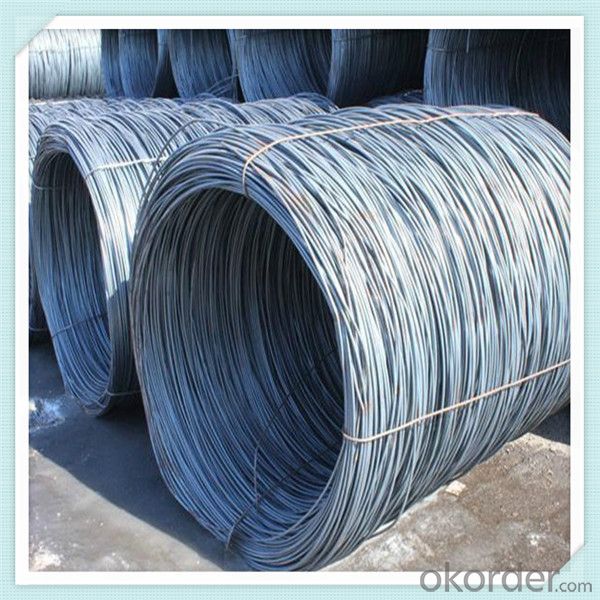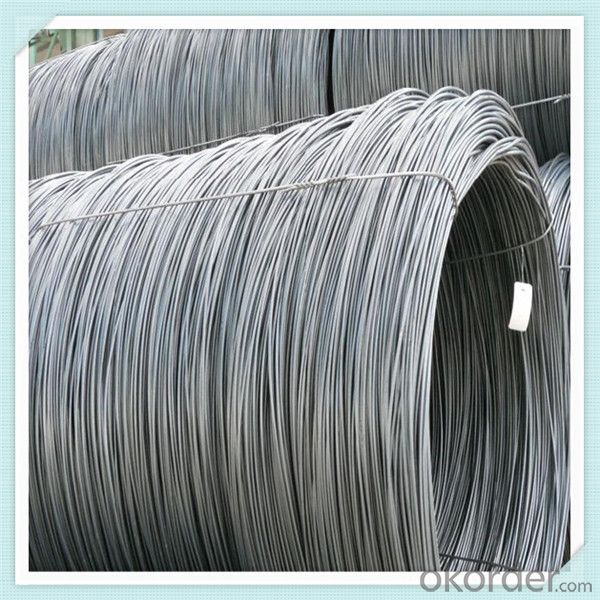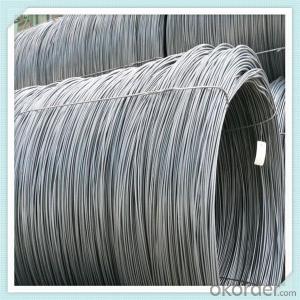SAE1008 Steel wire rod low carbon in good quality
- Loading Port:
- China main port
- Payment Terms:
- TT OR LC
- Min Order Qty:
- 100 m.t.
- Supply Capability:
- 18400 m.t./month
OKorder Service Pledge
OKorder Financial Service
You Might Also Like
Item specifice
Features
1、Pure steel quality, stable chemical contents, small tolerance.
2、Constant Quality, good drawing performance.
3、High dimension accuracy degree, accuracy degree of Level C up to 80%, smooth surface, less scale,
easy to be pickled.
4、Automatic bundling with 4 lines by Machine in tidy and good looks
5、Big high quality percentage, small coil percentage, and heavy coil weight for Hard Coil.
6、High sorbitizing percentage.
Steel wire is mainly used for prestressed and posttensioning technology in various shapes of prestressed
concrete structures,and widely used for civil engineering construction, such as large scale railroad, highway
bridges, building trusses, overhead crane beams, industrial and prefabricated concrete floor, wall board,
tubular piles, PC water pipes, TV towers and nuclear power station, ETC. Active strandards:GB/T5223,
ASTMA421, BS5896, JISG3536, ISO6934, EN10138 or other special required standards.
Product Description :
Standard | AISI, ASTM, BS, DIN, GB, JIS |
Material/steel grade | Q195-Q235,SAE1006B,SAE1006CR, SAE1008B, SAE1008CR, SAE1010B, SAE1018B, or according to customers requirements |
Wire Gauge | 5.5-12mm |
Coil weight | 1.8-2.1mts |
MOQ | 25MT |
Delivery Time | 15-30 days after receipt of L/C or deposit by T/T |
Packing | In coil and load in container, if large quantity, by bulk vessel; Can be packed as customers' special requirements |
Payment terms | 1).100% irrevocable L/C at sight. 2).30% T/T prepaid and the balance against the copy of B/L. 3).30% T/T prepaid and the balance against L/C |
Application | widely used in machinery parts, manufacturing industry, electronics industry, metal tools and others |


Application :
It generally used in braiding the hose for bathing product and machinery. With it
good flexibility, resistant to high temperature and resistant to corrosion, it
used widely in many industries.
Packing :
Hot-rolled wire rod is held in a unit with at least four steel straps in the
transverse direction and transported and stored without further packaging.
Before
the steel strapping is applied, the wire rod must be sufficiently compressed.
The strapping is fixed in the transverse direction with a single circumferential
strap so that the strapping does not slip and cause the coil to come apart.


Our service:
(1) We cooperate with famous factories with advanced equipment and well trained workers.
(2) We can provide factory price with trading company service.
(3) We continuously work on the improvement of our processes, guaranteeing
consistently high standards of quality to keep none compensation.
(4) We guarantee 24 hours response and 48 hours solution providing service.
(5) We accept small order quantity before formal cooperation.
(6) We deliver the agreed quality at the agreed time, reacting to changes in
customer wishes in a flexible way.
(7) Due to our volume and selling power, we have excellent freight rates with
shipping lines.
(8) We strive to always be fair and honest in our dealings with customers.
(9) We strive to work together with customers to achieve much more than we can
achieve alone.
(10) Through our passion and commitment we aim to be a market leader in all our
key markets. To maintain our position as market leader we must continue to add
value in all that we do.
FAQ:
1.Q: What's your MOQ(minimum order quantity)?
A: One full container, mixed acceptable .
2. Q: What's your packing methods?
A: Packed in bundle or bulk ..
3. Q: How can I buy CNBM products in my country?
A:Please send us an inquiry or email ,we will reply to you if there is distributor in your country
4. Q: Can we visit your factory?
A: Warmly welcome. Once we have your schedule, we will arrange the
professional sales team to follow up your case.
5. Q: How long does it take to get the product if i place an order?
A:With the process of your requirements,we will pack and deliver in 3
-7 days. If it is by sea shipment,it will take 15-45 days depending on different locations
- Q:How is steel wire rod tested for ultimate tensile strength?
- Steel wire rod is typically tested for ultimate tensile strength using a universal testing machine. This machine applies a steadily increasing force to the rod until it fractures. The force required to break the rod is measured, and this value represents the ultimate tensile strength of the steel wire rod.
- Q:How is steel wire rod used in the manufacturing of wire rope assemblies for mining applications?
- Steel wire rod is an essential element in the production of wire rope assemblies used in mining operations. These assemblies are utilized for lifting and transporting heavy loads, ensuring stability and support, and guaranteeing worker safety. To manufacture steel wire rod, the initial step involves melting steel scrap in a furnace and continuously casting the molten steel into billets or blooms. These billets are then hot rolled into long, slender rods with diameters ranging from a few millimeters to several centimeters. Once the steel wire rod is produced, it undergoes a series of processes to convert it into wire rope. Wire drawing is the first step, where the rod is pulled through a series of dies to reduce its diameter and increase its length. This process also enhances the wire's surface finish and mechanical properties. Following wire drawing, a lubricant is typically applied to the steel wire to reduce friction and enhance corrosion resistance. This lubricant also provides protection during subsequent manufacturing processes. Next, the wire is twisted together to form strands. The specific application and required strength of the wire rope assembly determine the number of strands and the design of the twist pattern. The strands are then helically laid around a central core, providing additional strength and support. Finally, the wire rope assembly undergoes a process called closing, where the entire length of the assembly is compressed to ensure tightness and secure holding of all the strands. This closing process also improves the overall structural integrity of the wire rope assembly. In mining applications, wire rope assemblies made from steel wire rod are employed in various ways. They are commonly used in hoisting systems for lifting heavy loads, including equipment, ore, and personnel. These assemblies also serve suspension and support purposes, providing stability to underground tunnels and shafts. Furthermore, wire rope assemblies are utilized in safety applications, such as fall protection systems and rescue operations. Overall, steel wire rod plays a vital role in manufacturing wire rope assemblies for mining applications. Its strength, durability, and flexibility make it an ideal material for withstanding the demanding conditions and heavy loads commonly encountered in the mining industry.
- Q:What are the main factors influencing the choice of steel wire rod production process?
- Several key factors influence the selection of the steel wire rod production process. Firstly, the quality requirements of the final product play a vital role. Each production process has its own capabilities in producing steel wire rods with specific properties such as strength, ductility, and surface finish. The desired characteristics of the wire rod will determine the appropriate production process. Secondly, the cost-effectiveness of the production process is an important consideration. The overall cost of production can be significantly affected by factors like energy consumption, raw material utilization, and labor requirements. It is crucial to evaluate the efficiencies and costs of different processes to make the most economical choice. Moreover, the availability and cost of raw materials also impact the selection of the production process. Steel wire rods can be made from various types of steel, including carbon steel, alloy steel, or stainless steel. The choice of raw material depends on factors such as required mechanical properties, availability, and cost. The production process must be compatible with the chosen raw material. Another factor to consider is the production capacity and scalability of the process. Some processes are more suitable for small-scale production, while others are better suited for large-scale manufacturing. The desired production volume and scalability requirements must be taken into account to ensure the chosen process can meet the production demands. In addition, environmental considerations can also influence the choice of production process. Some processes may generate more waste or emit higher levels of pollutants compared to others. Companies may prioritize sustainable and environmentally friendly production methods, leading them to select a process that minimizes environmental impact. Overall, the selection of the steel wire rod production process is influenced by factors such as desired product quality, cost-effectiveness, availability and cost of raw materials, production capacity and scalability, and environmental considerations. A careful evaluation of these factors is necessary to choose the most suitable production process for a specific application.
- Q:How is steel wire rod classified based on its surface condition?
- Steel wire rod can be categorized into three main groups based on its surface condition. The first category is bright or untreated surface, which refers to wire rod that has not undergone any surface treatment or coating. This type of wire rod has a clean and smooth surface, without any contaminants or oxidation. It is commonly used in applications that require a clean appearance or high conductivity, such as electrical wire manufacturing, cable production, and spring production. The second category is coated or galvanized surface, which involves treating the wire rod with a protective layer, usually through galvanization or zinc coating. This protective coating enhances the wire rod's resistance to corrosion by acting as a barrier against moisture and other corrosive elements. It makes the wire rod suitable for outdoor applications or environments with high humidity or exposure to chemicals. Industries like construction, fencing, and automotive often use coated steel wire rod. The third category is coated and drawn surface, which refers to wire rod that has undergone both a coating and a drawing process. The coating is applied to the wire rod before it is drawn through a series of dies, reducing its diameter and increasing its tensile strength. This process results in a smooth and uniform surface with improved mechanical properties. Coated and drawn steel wire rod is commonly used in applications that require high-strength wire, such as wire ropes, tire reinforcement, and suspension springs. In conclusion, classifying steel wire rod based on its surface condition aids in determining its suitability for various applications, considering factors like corrosion resistance, conductivity, appearance, and mechanical properties.
- Q:What are the different grain size measurement methods for steel wire rod?
- There are several grain size measurement methods for steel wire rod, including optical microscopy, electron backscatter diffraction (EBSD), X-ray diffraction (XRD), and image analysis. Optical microscopy involves examining the sample under a microscope and measuring the average grain size. EBSD is a technique that uses electron diffraction patterns to determine the crystal orientation and grain size. XRD measures the diffraction pattern of X-rays to determine the crystal structure and grain size. Image analysis involves capturing images of the sample and using software to analyze and measure the grain size.
- Q:What is the chemical composition of steel wire rod?
- The chemical composition of steel wire rod typically includes iron, carbon, manganese, silicon, and small amounts of other elements such as sulfur and phosphorus.
- Q:What are the common applications of oil tempered and tempered steel wire rod?
- Oil tempered and tempered steel wire rods have a wide range of applications across various industries. Some common applications include manufacturing springs for automotive suspension systems, mattress springs, mechanical fasteners, wire ropes, and cables. They are also used in the construction industry for reinforcing concrete structures, as well as in the production of power transmission equipment and industrial machinery.
- Q:How is steel wire rod used in the manufacturing of wire rope trays?
- Steel wire rod is used in the manufacturing of wire rope trays as the primary material for producing the wire ropes themselves. These wire ropes are then formed into trays that provide a secure and durable structure for holding and organizing various cables and wires in industrial settings. The steel wire rod's strength, flexibility, and resistance to corrosion make it an ideal choice for constructing wire rope trays that can withstand heavy loads and harsh conditions.
- Q:What are the different types of steel wire rod surface defects and their impact?
- Steel wire rods can exhibit various surface defects, each of which has its own distinct effect on the quality and performance of the product. The ensuing list highlights some commonly encountered defects and their corresponding consequences: 1. Scale: During manufacturing, steel wire surfaces may develop scale, an oxide layer. This layer can manifest as a thick, flaky coating or a thin, tightly adhered film. Scale can detrimentally impact the wire rod's surface finish and corrode its resistance. 2. Pits: Small depressions or cavities, termed pits, can arise on the wire rod's surface. These pits result from impurities or inclusions in the steel or mechanical damage during processing. Pits can diminish the wire rod's strength and integrity, making it prone to failure when subjected to stress. 3. Scratches and gouges: Physical marks, namely scratches and gouges, can mar the wire rod's surface due to contact with abrasive surfaces or mishandling. Such defects create points of stress concentration, compromising the wire rod's strength and raising the risk of fracture or breakage. 4. Laps and seams: Laps and seams are surface irregularities or discontinuities that often occur due to improper rolling or handling. These flaws can affect the wire rod's dimensional accuracy and diminish its overall strength and ductility. 5. Decarburization: When exposed to high temperatures during processing, the wire rod's surface layer may experience decarburization, resulting in the loss of carbon. This can lead to a softer and weaker surface layer, reducing wear resistance and fatigue strength. 6. Corrosion: Chemical reactions with the environment cause corrosion, which leads to the deterioration of the wire rod's surface. This corrosion can manifest as rust or other oxidation forms. Corrosion significantly diminishes the wire rod's lifespan and performance, especially when exposed to moisture or corrosive substances. In general, these surface defects have adverse effects on the quality, strength, and durability of steel wire rods. Implementing proper quality control measures and inspection techniques is crucial to identify and mitigate these defects, ensuring that the wire rods meet specified requirements and perform optimally in their intended applications.
- Q:How is steel wire rod used in the manufacturing of wire forms for safety barriers?
- Steel wire rod is an essential component in the manufacturing of wire forms for safety barriers. The process starts with the selection of high-quality steel wire rod, which is typically made from carbon or alloy steel. This wire rod is then subjected to several manufacturing processes to create wire forms that are strong, durable, and capable of providing the necessary safety features. The first step in the manufacturing process is the drawing of the wire rod. This involves pulling the wire rod through a series of dies to reduce its diameter and increase its length. Drawing is important to ensure that the wire forms have a consistent diameter and smooth surface finish. Once the wire rod is drawn, it is then cut into the desired length for the wire forms. These lengths are typically determined based on the specific requirements of the safety barriers. The cut wire rod is then formed into the desired shape using various techniques such as bending, twisting, or welding. After the wire rod is shaped into the appropriate form, it is often coated or treated to enhance its performance and durability. For example, a galvanized coating can be applied to protect the wire form from corrosion and increase its lifespan. Additionally, the wire forms may undergo heat treatment processes to improve their mechanical properties, such as strength and hardness. The wire forms manufactured from steel wire rod are then assembled into safety barriers. These barriers are used to prevent accidents, control traffic, and provide security in various applications such as highways, construction sites, and industrial facilities. The strength and durability of the wire forms ensure that the safety barriers can withstand impact and provide effective protection. In summary, steel wire rod plays a crucial role in the manufacturing of wire forms for safety barriers. It provides the necessary strength, durability, and stability required for these barriers to effectively protect people and property. The wire rod undergoes various manufacturing processes to create wire forms that are capable of withstanding impact and providing long-lasting performance.
1. Manufacturer Overview |
|
|---|---|
| Location | |
| Year Established | |
| Annual Output Value | |
| Main Markets | |
| Company Certifications | |
2. Manufacturer Certificates |
|
|---|---|
| a) Certification Name | |
| Range | |
| Reference | |
| Validity Period | |
3. Manufacturer Capability |
|
|---|---|
| a)Trade Capacity | |
| Nearest Port | |
| Export Percentage | |
| No.of Employees in Trade Department | |
| Language Spoken: | |
| b)Factory Information | |
| Factory Size: | |
| No. of Production Lines | |
| Contract Manufacturing | |
| Product Price Range | |
Send your message to us
SAE1008 Steel wire rod low carbon in good quality
- Loading Port:
- China main port
- Payment Terms:
- TT OR LC
- Min Order Qty:
- 100 m.t.
- Supply Capability:
- 18400 m.t./month
OKorder Service Pledge
OKorder Financial Service
Similar products
New products
Hot products
Related keywords


























